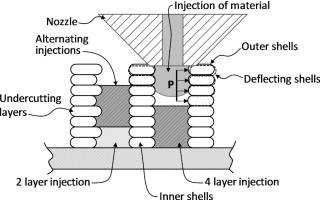- FMA
- The Fabricator
- FABTECH
- Canadian Metalworking
Our Publications
Categories
- Additive Manufacturing
- Aluminum Welding
- Arc Welding
- Assembly and Joining
- Automation and Robotics
- Bending and Forming
- Consumables
- Cutting and Weld Prep
- Electric Vehicles
- En Español
- Finishing
- Hydroforming
- Laser Cutting
- Laser Welding
- Machining
- Manufacturing Software
- Materials Handling
- Metals/Materials
- Oxyfuel Cutting
- Plasma Cutting
- Power Tools
- Punching and Other Holemaking
- Roll Forming
- Safety
- Sawing
- Shearing
- Shop Management
- Testing and Measuring
- Tube and Pipe Fabrication
- Tube and Pipe Production
- Waterjet Cutting
Industry Directory
Webcasts
Podcasts
FAB 40
Advertise
Subscribe
Account Login
Search
Paper highlights process that combines 3D printing and injection molding
- August 27, 2020
- News Release
- Additive Manufacturing
Researchers at the University of Massachusetts Lowell, David O. Kazmer and Austin Colon, have authored a paper published by the peer-reviewed journal Additive Manufacturing about a process they developed called injection printing. The process combines 3D printing with elements of injection molding to produce stronger parts while reducing production time.
Material extrusion is a popular process for both prototyping and digital manufacturing, yet it is lacking in terms of part strength, feature resolution, and production rate relative to alternative processes. Injection printing addresses these issues by combining material extrusion of the outer surfaces of the part at fine resolution with injection molding of larger interior cavities at high flow rates. Injection printing thus aims to use the full melting capacity of material extrusion printers to mitigate dimensionality. The paper, titled “Injection printing: additive molding via shell material extrusion and filling,” presents simple governing models for flow in the formed cavities, as well as the stress and deflection of the shell walls.
To validate the performance of injection printing relative to material extrusion, impact specimens and tensile bars were printed of acrylonitrile butadiene styrene. The tensile and impact results of the samples were compared, and image analysis was performed on the post-test samples. It was found that injection printing increased print speeds by an average factor of 3.2 relative to conventional material extrusion using the same linear print velocities. The stiffness, strength, and strain-to-failure of injection-printed tensile bars (in-plane) were respectively increased by 21%, 47%, and 35% compared to material extrusion. Properties of impact specimen and vertically printed tensile bars also showed promising gains, albeit with constraints related to the printer’s melting capacity. Even so, injection printing is shown as a broadly applicable and readily accessible process for increasing part strength and production rate while enabling improved feature resolution without greatly extended print times.
The authors cite the following benefits of injection printing:
- Material extrusion prints shells to form cavities that are filled like injection molding.
- Interleaved printing/injecting reduces dimensionality of material extrusion AM.
- Material injection enables more rapid and dense part production.
- Denser parts have more isotropic properties that approach injection molded.
- Closed-loop melt pressure control during injection can tighten tolerances.
- Podcasting
- Podcast:
- The Fabricator Podcast
- Published:
- 04/16/2024
- Running Time:
- 63:29
In this episode of The Fabricator Podcast, Caleb Chamberlain, co-founder and CEO of OSH Cut, discusses his company’s...
- Trending Articles
- Industry Events
16th Annual Safety Conference
- April 30 - May 1, 2024
- Elgin,
Pipe and Tube Conference
- May 21 - 22, 2024
- Omaha, NE
World-Class Roll Forming Workshop
- June 5 - 6, 2024
- Louisville, KY
Advanced Laser Application Workshop
- June 25 - 27, 2024
- Novi, MI

























